This task shows you how to create a Distributed Force applied to a virtual part or to a geometry selection.
Distributed Forces are force systems statically equivalent to a given pure force resultant at a given point, distributed on a virtual part or on a geometric selection.
The aim of the distributed force load is not to uniformly
distribute the force on the selected supports. To achieve that, the usage
of force densities or pressure is recommended.
The exact behavior of the distributed force can be simulated by creating a
smooth virtual part with the same support as the distributed force and
applying a punctual force on its handler.
Note that therefore the results depends on the meshing (all nodes are
equally taken into account in the distribution).
For more details, refer to the example at the end
of this task.
Units are force units (typically N in SI).
You have to specify three components for the direction of the resultant force, along with a magnitude information. Upon modification of any of these four values, the resultant force vector components and magnitude are updated based on the last data entry. The resultant force vector remains constant independently of the geometry selection.
The point of application of the force resultant is automatically defined as follows:
- For extended geometries, this point is the center of the geometry.

In the case the geometrical support selected gives access to several mesh parts (such as transformed mesh parts), the default handler point is still computed with respect of the geometry.
In this case, it is strongly recommended to select a user-created handler point.
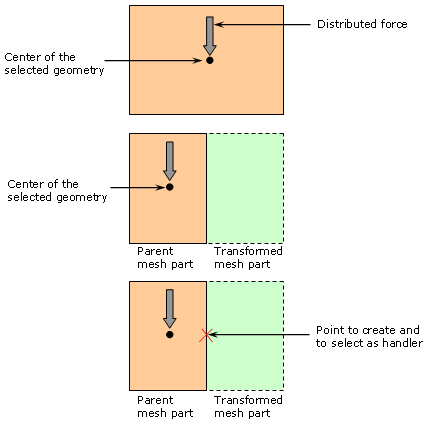
- For virtual parts, this point is the handler of the virtual part.
The given single-force system is processed by the program as follows:
- In the case of extended geometries, it is transformed into an equivalent force system distributed over the selected support.
- In the case of virtual parts connected to deformable bodies, it is
transmitted as a force system collectively to the entire connected
geometry.
Distributed Force objects belong to Loads objects sets.
Distributed Forces can be applied to the following types of supports:
|
Geometrical Feature |
Mechanical Feature |
Analysis Feature |
||||
|
Spatial Groups |
Geometrical Groups |
Groups by Neighborhood |
Groups by Boundary |
Others |
||
|
Point/Vertex (homogeneous selection) |
|
|
|
|
|
Virtual Part |
To know more, refer to Authorized Supports.
Open the sample00.CATAnalysis document from the samples directory.
-
Make sure the Shading, Outlines and Materials options are active in the Custom View Modes dialog box ( View > Render Style > Customize View).
-
Click Distributed Force
 in the Loads toolbar.
in the Loads toolbar.The Distributed Force dialog box appears.
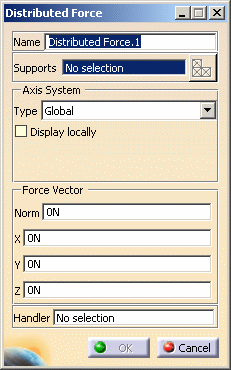
- Name: lets you modify the name of the load.
- Supports: lets you select supports on which you want
to apply a distributed force.
Multi-selection of geometries and groups is available. The multi-selection must be homogeneous.
Multi-selection of virtual parts is not available. Moreover, you cannot select a virtual part and a geometry (or a group). - Axis System: fore more details, refer to the third step.
- Force Vector: lets you specify the three components for the direction of the resultant force, along with a magnitude information. The resultant force vector remains constant independently of the geometry selection.
- Handler: lets you select a point (if you selected geometries as Support) or a handler point of a virtual part (if you selected a virtual part as Support).
-
If needed, change the identifier of the distributed force by editing the Name field.
-
Set the Axis System Type.
-
Enter values for the X, Y, Z components of the resultant force vector.
For example, enter -50N as Z value.
The remaining three fields are automatically computed and displayed.
The visualized symbols orientation will also reflect the modification, once the support will be selected. -
Select the support (a virtual part or a geometry) on which the resultant force vector is applied at the pre-defined point.
Any selectable geometry is highlighted when you pass the cursor over it.
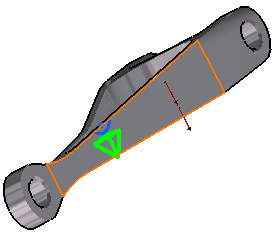
You can select several supports in sequence, to apply the Distributed Force to all supports simultaneously.
A symbol representing the resultant force equivalent to the Distributed Force is displayed at the application point of the support to visualize the input force system.The Distributed Force dialog box now appears as shown here:
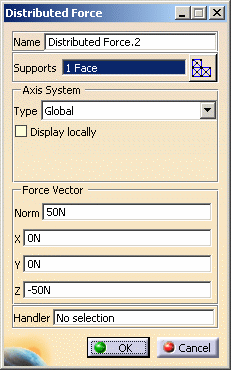
As soon as the support is selected, the Select Mesh Part button is available.
To know more about the Select Mesh Part button, refer to Selecting Mesh Parts. -
Optionally, select a point as Handler.
-
Click OK.
A Distributed Force.2 object appears in the specification tree under the active Loads objects set.
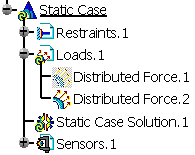
Be aware that the Distributed Force applies directly to the nodes of the selected entity, whereas a Surface Density Force, or a Pressure, applies to the element faces of the selected entity. The latter type of forces is far more accurate and should be used whenever equivalent to the Distributed Force.
As an example, consider a coarsely meshed cylinder whose
top surface has been submitted to a distributed force and whose bottom
surface is clamped. As the nodes on the edges have less neighbors that
inner nodes, they are pulled a lot further than the inner nodes, thus
leading to an erroneous result near the edges. Mesh refinement is needed to
get proper results.
On the contrary, the surface density force leads to a smoother and more
accurate displacement.
You can open DistribForce.CATAnalysis and compute all the model.
Applying a Distributed Force results as shown here: (first static case)
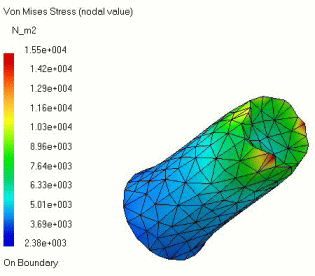
Applying a Surface Density Force results as shown here: (second static case)

The ELFINI Structural Analysis product offers the following additional functionalities:
-
Contextual menu on the load object:
- Distributed Force Visualization on Mesh: the translation
of the load specifications into solver
specifications can be visualized symbolically at the impacted mesh
nodes, provided the mesh has been previously generated using a mesh
only computation.
To know more, refer to Visualizing Loads on Mesh.
- Distributed Force Visualization on Mesh: the translation
of the load specifications into solver
specifications can be visualized symbolically at the impacted mesh
nodes, provided the mesh has been previously generated using a mesh
only computation.
-
Contextual menus on the Loads set:
- Generate Image: generates an image of the computed loads (along with translating all user-defined
load specifications into
explicit solver commands on mesh entities), by generating symbols for
the elementary loads imposed by the loads sets. The image can be
edited to include part or all of the options available.
To know more, refer to Generating Images. - Report: the partial status and results of intermediate
pre-processor computations are reported in HTML format. It represents a
subset of the global report capability and generates a partial report
of the loads set computation.
To know more, refer to Generating Reports.
- Generate Image: generates an image of the computed loads (along with translating all user-defined
load specifications into
explicit solver commands on mesh entities), by generating symbols for
the elementary loads imposed by the loads sets. The image can be
edited to include part or all of the options available.
- Self-balancing: you can double-click the Loads
set to automatically add inertia forces in order to counter balance
external loads.
Double-click the Loads set to display the Loads dialog box that lets you choose whether you wish to apply self-balancing to the load. Example of use: if this option is used with iso-static specifications, it will allow you to simulate free-body loading. If you make the option active, the center of inertia results null.
To know more, refer to Creating Pressures.
![]()